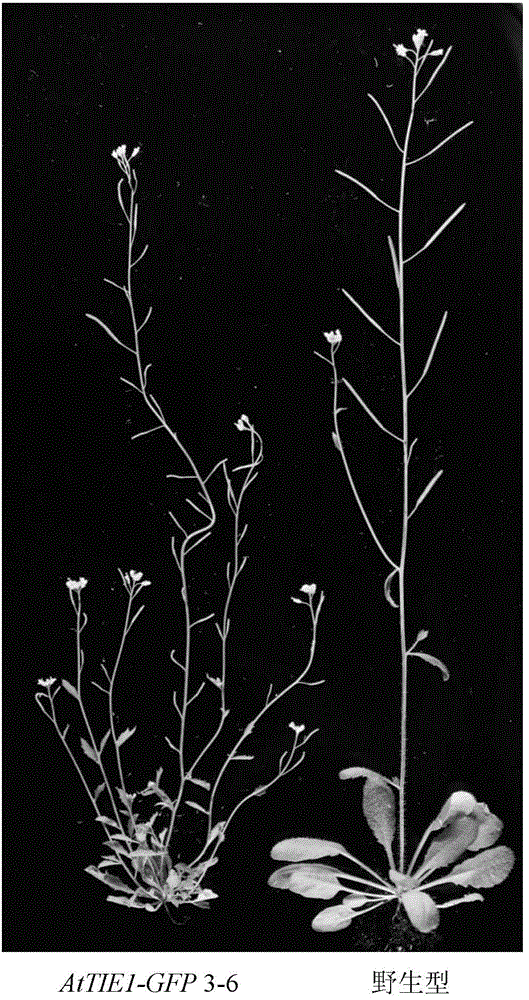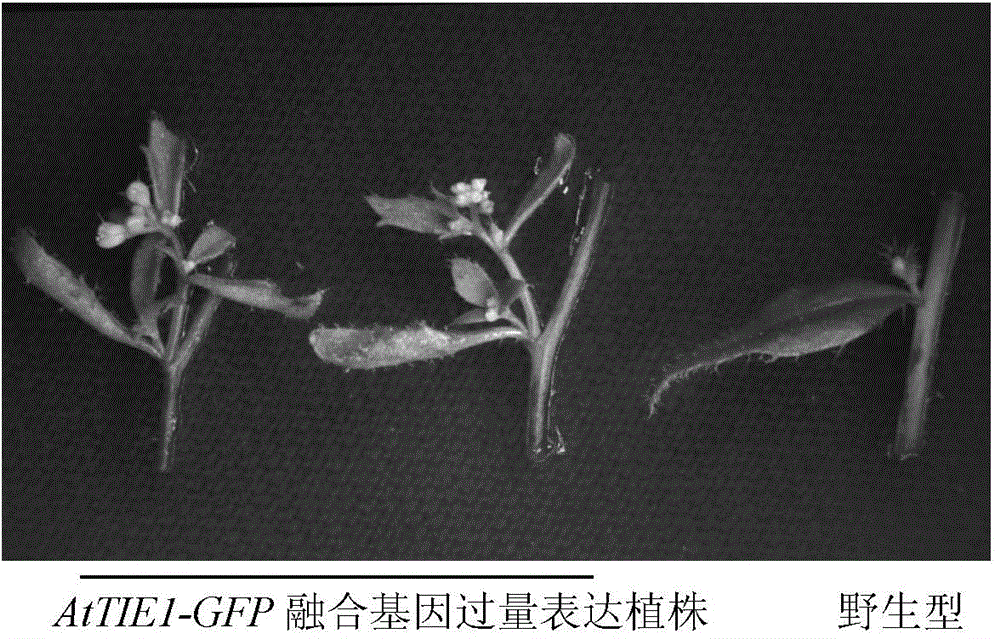Arabidopis thaliana gene AtTIE 1 controlling plant branching and applications thereof
An Arabidopsis thaliana and gene technology, applied in the field of plant genetic engineering, can solve problems such as the lack of elucidation of the regulatory mechanism, and achieve the effect of increasing the number of branches
- Summary
- Abstract
- Description
- Claims
- Application Information
AI Technical Summary
Problems solved by technology
Method used
Image
Examples
Embodiment 1
[0027] Embodiment 1, the cloning of gene and the construction of plant expression vector
[0028] (1) Cloning of AtTIE1 gene cDNA sequence:
[0029] The genomic DNA sequence, cDNA sequence and amino acid sequence of the AtTIE1 gene were obtained from The Arabidopsis Information Resource Arabidopsis genome database (http: / / www.arabidopsis.org / ).
[0030] Design gene-specific PCR primers based on the CDS sequence of the TIE1 gene:
[0031] F1: 5'-CACCATGGGTAGTAGTTTTTTTCGGGAGAC-3' (SEQ ID NO: 4);
[0032] R1:5'-CAATCTCAATTCCAAATCTAGC-3' (SEQ ID NO:5).
[0033] Using this pair of primers, the CDS sequence of TIE1 gene without stop codon was cloned from the cDNA library of Arabidopsis thaliana Colombia ecotype (built in our laboratory).
[0034] (2) Construction of an entry vector for overexpressing the TIE1-GFP fusion gene
[0035] The PCR product was connected into the pENTR / D-TOPO vector (Invitrogen Company) through TOPO reaction, and the vector with the forward insert fragm...
Embodiment 2
[0038] Example 2, Obtaining of Transgenic Arabidopsis Constitutively Expressing TIE1-GFP Fusion Gene
[0039] (1) Obtaining Arabidopsis plants for transformation:
[0040] Select plump Arabidopsis Colombia ecotype seeds, first use 70% ethanol for surface disinfection, then use 15% sodium hypochlorite aqueous solution for sterilization, wash with sterile water for 5 times, and evenly place on 1 / 2MS solid medium After 2 days of inverted culture at 4°C, place it in a light incubator at 22°C for about 7 days under long-day light (16 hours of light / 8 hours of darkness), transfer it to soil, and place it in a greenhouse at 22°C under long-day light (16 hours of light / 8 hours of darkness). hours in the dark) until the plants bolted and produced inflorescences.
[0041] (2) Agrobacterium transformation
[0042] The plant overexpression vector containing the TIE1-GFP fusion gene was transformed into Agrobacterium GV3101 competent cells by electric shock method, and spread on the cult...
Embodiment 3
[0049] Example 3, constitutive expression of TIE1-GFP fusion gene increases the number of branches of Arabidopsis
[0050] (1) Detection of the expression level of TIE1-GFP fusion gene in transgenic Arabidopsis and wild-type Arabidopsis
[0051] Cut the leaves of wild-type and transgenic Arabidopsis plants, extract total RNA with Trizol reagent (Invitrogen), treat and digest DNA with DNaseI (TaKaRa), and perform reverse transcription using a reverse transcription kit (Promega) to obtain transgenic plants and wild-type Plant cDNA. Gene-specific real-time quantitative PCR primers realF and realR were designed according to the DNA sequence of the TIE1-GFP fusion gene, and the expression level of the TIE1-GFP fusion gene in transgenic plants was detected by RT-PCR.
[0052] The internal reference gene is the UBQ10 gene of Arabidopsis thaliana (primers use realF2 and realR2), and the sequences of each primer are as follows:
[0053] realF: 5'-TCTCAGCCTCACAGAGCCACCAAGTT-3' (SEQ ID...
PUM
 Login to View More
Login to View More Abstract
Description
Claims
Application Information
 Login to View More
Login to View More - R&D
- Intellectual Property
- Life Sciences
- Materials
- Tech Scout
- Unparalleled Data Quality
- Higher Quality Content
- 60% Fewer Hallucinations
Browse by: Latest US Patents, China's latest patents, Technical Efficacy Thesaurus, Application Domain, Technology Topic, Popular Technical Reports.
© 2025 PatSnap. All rights reserved.Legal|Privacy policy|Modern Slavery Act Transparency Statement|Sitemap|About US| Contact US: help@patsnap.com



